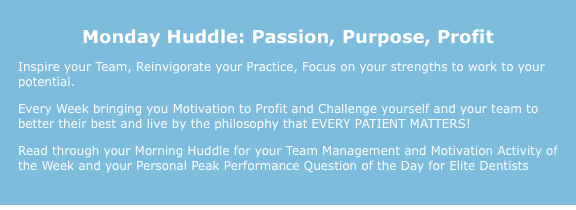I got so much great feedback from last week’s message. THANK YOU, I truly enjoy your stories. I thought we should take this a step further and dig deeper into some of the ways to increase case acceptance very easily.
Maybe you all sold more treatment last week than ever before. Remember, that means we helped more people get healthy and we never have to sell anything if our patient experience is dialed in properly. They will “sell” themselves by asking for the treatment to solve the problems you have illustrated, demonstrated and discussed with them.
I can sit here and write out all the tips in the world of what to do. However, more often than not, the problem is that you are doing the wrong things that negate the benefit of and counter act the smart things you are doing well.
That’s a brain teaser, but important enough to read again. You can do everything right but sabotage yourself in key ways (or have other team members sabotage you), and never realize it.
So, we begin with a series of five critical things to avoid and rid from your patient experience and practice systems once and for all.
I’m not going to tell you what they are in advance – so stay tuned and pay attention to each of these every week.
And please remember: no matter how good you are, you can always improve your consistency, your effectiveness, your size of case and percentage of acceptance on total full mouth comprehensive treatment plans or specialty procedures.
Case Acceptance Destroyer and Sabotage Trait #1 of 5:
Ineffective use of Photographs and X-Rays
Now, before you pass this off as basic, let’s be clear about a few things. Here’s what matters…
How clearly the pictures are.
How you talk about them.
And which ones you take.
The proper method of course is a full series of x-rays. Then a complete series of smile photos. The good old fashion cosmetic based pictures that show retracted view smile photos mouth open and closed, side views and top and bottom of the occlusal view of the entire arch and every single tooth. Then you have intraoral pictures either a tour of the mouth as ideal or quadrant shots.
It is not good enough just to take these without comment. You have to be good at it, you have to talk with patients throughout the process explaining what we are looking for and what you see.
Now most importantly, there are three ways to sabotage yourself with the pictures…
1 st – Not taking them at all or enough or the right ones or them not being clearly depictive of what we want the patient to see.
2 nd – Not having the patient look at the pictures and discussing the treatment directly from the photographs and using these illustrations to point them out.
3 rd – Not repeating #2 with the doctor and making sure the doctor is also talking from the photographs.
If you want a bonus… it’s to make sure the pictures travel with the patient to the treatment coordinator and they are reviewed a 3 rd time when actually going over the treatment.
Pictures will literally make magic happen and make your life so much easier. But, remember this: pictures won’t do anything by themselves.
You don’t want to leave the pictures up to the patients’ comprehension. You want to bring them to life, educate on the problems you see and begin to build the case by empowering the patients to talk about what they want to change.
The good news is just taking more pictures and practicing this will make all the difference in the world. I promise. No matter how good you already are, you can’t ever get good enough at this.
The real masters don’t stop at taking pictures, they weave them into their patient engagement and help the patients’ imagination take over to build the treatment plan based on the visions they wish to see. After it all, they get the patients to want it more than they did when they first arrived.
For all patients, this matters. This is the biggest way practices sabotage themselves because they never give themselves a chance to really get to ideal, optimal, full mouth makeover style dentistry and are stuck with small single tooth, at best quadrant work and basic restorative dentistry. All because they fail to effectively use, take or talk about the pictures of their patients’ mouths.
I will never stop saying this: patients believe what they see not what you say. Package those two things together and you have a winning combination.



